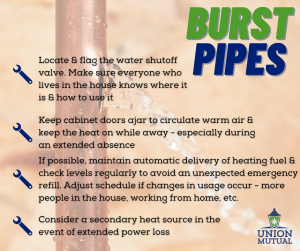Burst Pipes – What You Need to Know Before it Happens in Your Home

Did you know – water losses as a result of a frozen/burst pipe can cost at least $5,000 to repair? That’s not counting the headache of living through the disruption while construction/repairs are made, and certainly not accounting for the potential loss of valuable personal items. Living in the Northeast means regular stretches of below-freezing temperatures, which can be hard on the utilities within our homes. Of particular risk of freezing are pipes located within exterior walls and in typically unheated spaces like attics and garages. Be sure you know where the water shutoff valve is in your home, and that everyone who can be responsible for shutting it off knows how to do so.
There are several easy steps you can take to help prevent the pipes in your home from freezing, and then bursting, causing a costly water loss:
- Keep cabinet doors ajar to circulate warm air, and in the event of a below-freezing stretch, let the faucet trickle to keep the water flowing through the pipes
- Maintain a consistent temperature in your home of at least 55 degrees, and ensure you have enough fuel to sustain a reasonable amount of time. If you need to adjust the delivery schedule with your fuel dealer, do so in plenty of time prior to a storm
- If you are going to be away for an extended period, be sure to set the heat at at least 55 degrees and arrange for a trusted person to check on your home regularly – inside and outside – to prevent a costly surprise to welcome you home
- Consider a safe secondary heat source in the event of a prolonged power loss, as many fuel sources will not work without electricity
If a frozen pipe does happen, here are some tips on safely thawing the pipe:
- Have heat tape or a heating pad on hand to wrap the frozen pipe
- Use a hair dryer on the frozen pipe – but not any sort of open-flame torch
- Turn on the water at a trickle so you know when the water begins to flow again
- Keep working, slow and steady, until full pressure returns
Additional Resources:
Union Mutual Blog: Don’t Let Frozen Pipes Happen to You
Union Mutual Blog: Ice Dams – The Hidden Danger
Consumer Reports: How to Prevent Your Pipes from Freezing
American Red Cross: Preventing & Thawing Frozen Pipes



